The shrimp aquaculture sector represents one of the most lucrative and fastest growing segments of the global seafood industry. Farming practices currently employed for shrimp vary widely both between and within countries, which vary according to the species farmed, the financial resources of the farmer and the production method employed.
Effective feed management in shrimp farming with reference with L.Vannamei
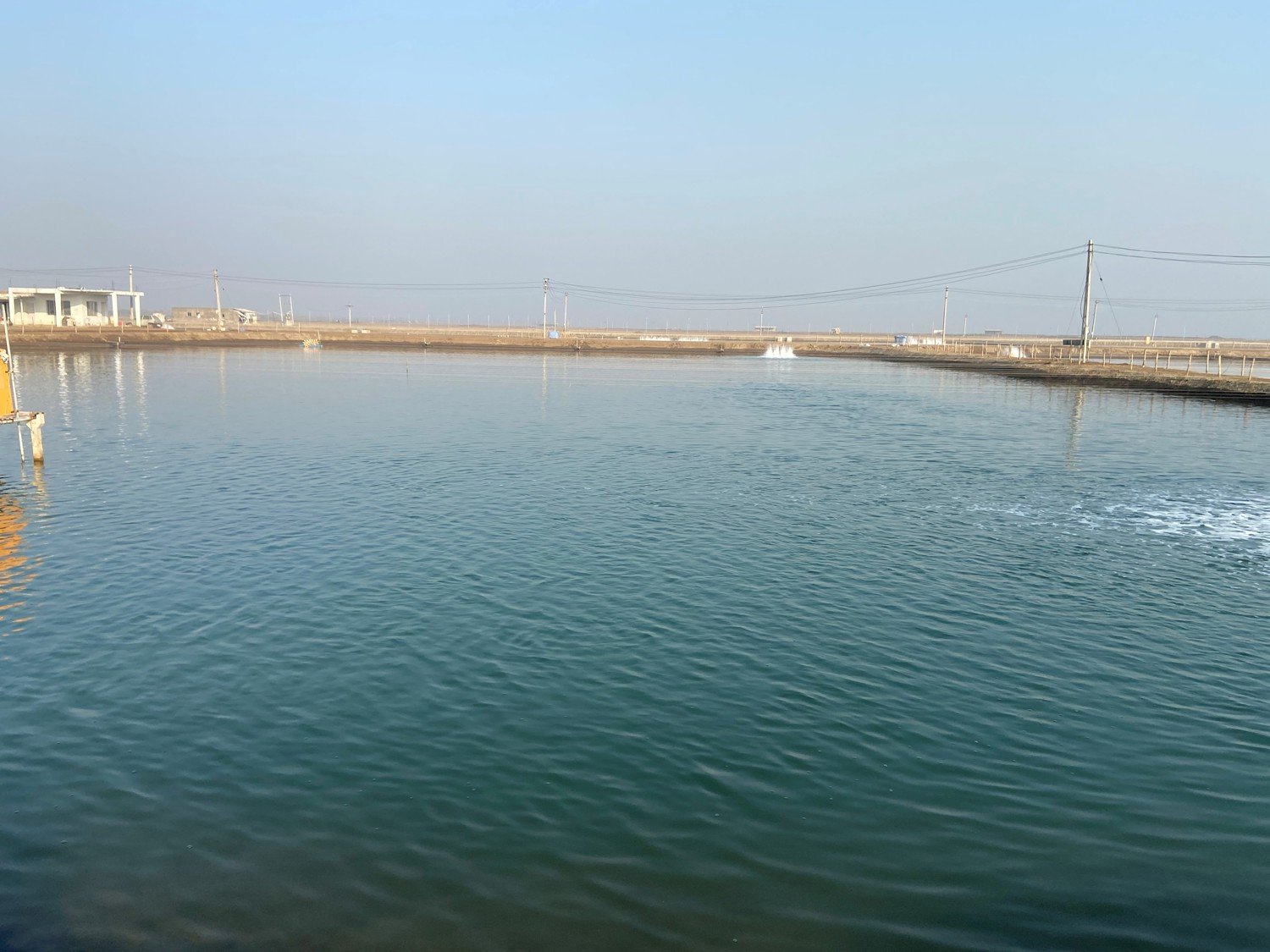
In general, shrimp production methods can be divided into three basic types depending upon the shrimp stocking density and the external inputs received over the production cycle; these range from extensive non-fed pond-based farming systems to semi-intensive compound feed-fed pond-based farming systems. There are a variety of methods used to estimate feed inputs. Irrespective of the methods employed, all feeding protocols should at least include the following considerations. First, feed utilization should be planned, and daily feed inputs should be limited. Daily inputs must be reasonable and should consider the growth of the shrimp as well as nutrient recycling capacity of the pond ecosystem. Growth is easily estimated based on weekly sampling of the shrimp.
Using nutritionally balanced feeds and adopting good feed management practices can improve the production efficiency and reduce the environmental impacts of the feed. It is generally recommended to use high quality feed that would result in better cost-effectiveness due to better digestibility and reduced nutrient load on the culture system. The use of not so well formulated feeds would fail to meet the nutritional requirements of culture species unavoidably causing inefficiencies and increased production costs. Nutritionally balanced feed is a prerequisite to lucrative production; nevertheless, the final success will depend on a combination of factors such as feed transport & storage, feeding regime and farm management, as depicted in Fig. 1.
Fig. 1: Factors affecting efficiency of shrimp farming
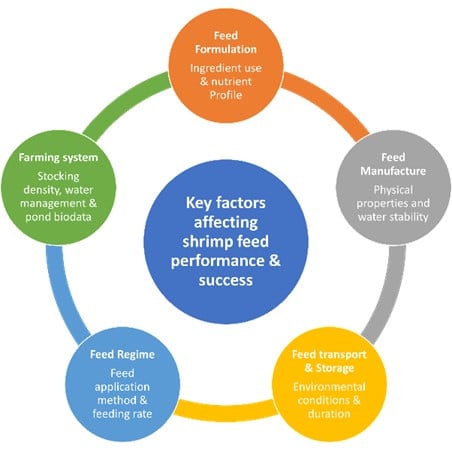
Well-managed feeding program will deliver precise feed rations to meet nutritional demands and suit feeding habits of culture animals at different development stages, ensuring effective nutrient utilization from both compound feed as well natural food.
Significance of Feed Management
In general, the nutritional performance of a shrimp feed depends upon five interconnected factors, namely:
- the nutrient content and composition of the diet being fed.
- the physical properties and water stability of the diet being fed.
- the transportation and storage of the diet prior to feeding on the farm.
- the feeding method employed for feed application and usage on the farm.
- the farming system, stocking density, water management and availability of
natural foods.
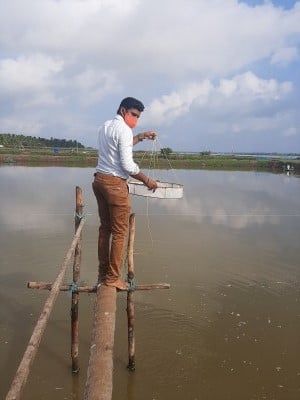
Factors Influencing Feed Management
Feeding Behavior of Shrimp
- In natural environmental conditions, shrimp are scavenging opportunistic feeders. Under farming conditions as well they harness food particles suspended in the water column (e.g., phytoplankton, zooplankton, microbial flocs, organic detritus, etc.) and food organisms living on the pond bottom (e.g., plant and animal biota), in addition to the compound feeds.
- Shrimp have poorly developed eyes and thereby vision, hence consequently rely primarily on chemical attraction and stimulation to locate and consume their food, including compound feeds. This necessitates the compound feeds to remain immersed in water for prolonged periods of time (typically for several hours) prior to being externally masticated and then consumed.
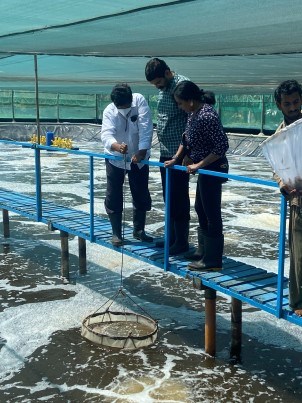
Factors Influencing the growth of the shrimps
Under practical farming conditions, the feeding response, feed intake (Expressed as percent shrimp body weight), feed utilization efficiency and growth of shrimp vary with numerous biological, environmental, and human factors, including:
- Shrimp body weight: compound feed intake decreases with increasing body weight and decreasing metabolic rate over the culture cycle.
- Water temperature: compound feed intake and growth increases with increasing water temperature up to an optimum level (typically between 29 and 310 C for L. vannamei and P. monodon), with water temperatures and consequently dissolved oxygen levels. This may sometimes vary widely over a working day depending upon the culture system used and season.
- Natural food availability: compound feed intake increases with decreasing natural food availability within the culture system (which includes natural foods present within the water column and/or pond bottom), with pond bottom natural food availability generally decreasing with increasing shrimp stocking density, increasing shrimp weight and increasing total shrimp biomass over the culture cycle.
- Compound feed formulation and nutrient density: feed intake and growth are dependent upon the water stability, palatability, and nutrient composition of the diet fed. The better the water stability and palatability and the higher the nutrient content of the diet fed, the higher the potential feed intake and feeding response of the diet (may not always be true).
- Shrimp feed application method: compound feed intake and growth are usually easier to control and monitor during daylight hours within smaller hand-fed intensively stocked ponds (as compared with larger semi-intensively stocked ponds), with optimum feeding frequency. The timing of application is dependent upon the size of the shrimp and the nutrient density of the diet fed, and generally being highest for small, rapidly growing shrimp, and thereafter decreasing with increasing shrimp size.
- Shrimp molt cycle, lunar cycle phase and feeding behavior: feed intake and growth is dependent upon the physiological state and condition of the shrimp, with feed intake usually decreasing immediately prior to and during the molting cycle and natural feeding activity being highest during non-daylight hours.
- Shrimp health and wellbeing, including ecosystem health: feed intake and growth are generally lowest for stressed and diseased shrimp, including those in polluted and environmentally stressed pond ecosystems.
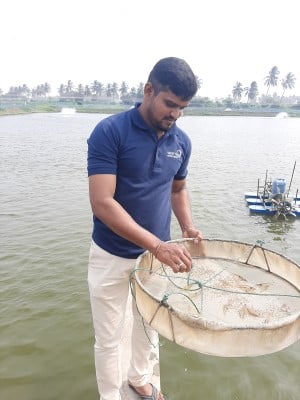
Effective Feed Management in Seasons
- In summer adjust the feed content to three times; skip afternoon feeding to reduce feed wastage. During high temperature gut retention capacity is less so it consumes more feed so increase feed according to check tray observation.
- In winter broadcast feed after sunrise because in lower temperatures feed intake will be less
- During rainy day decrease feed 10% in total daily feed ration
- Cloudy weather and rainy season adjust feeding according to check tray
- During molting time reduce feed by 10% in total daily feed ration
- Before feeding run aerators for 30 min so it increases more oxygen levels in water so feeding will be effective
- Reduce 5% feed during high ammonia and other toxicants in pond water
Nutritionally balanced feeds - Skretting Gamma & Lorica feeds
Gamma- Skretting’s feed with high protein and right pellet size are formulated with high precision to deliver balanced nutrition with equal emphasis been placed on species specific formulation. Gamma feeds promise to deliver optimal amino acid balance, immuno-stimulants and attractants which provides highly digestible and bio-absorbable nutrients along with apt palatability. This ensures that the nutritional requirement of the L.Vannamei is met leading to optimal growth of the shrimp in various rearing conditions.
Gamma feed comes in 8 different pellet sizes, according to the life stage of shrimp and thereby eliminates the possibility of size variation. Consistent quality and nutrient density in Gamma, enables lesser feed intake for specific growth rates, leading to better Feed Conversion Ratio (FCR). It also stimulates the feed intake, thus allowing the shrimps to reach their full growth potential and possesses excellent water stability.
At the same time Lorica- Skretting’s Functional Feed for Nursery Stage contains highly digestible protein with high animal protein inclusion suited for nurseries as well as high density farming. Lorica contains immunostimulants which effectively work against bacteria in gut leading to higher survival rate in shrimp. Lorica possesses all nutrients in line with the requirements of the L.vannamei in nurseries as well as grow-out ponds. Lorica can also be used during the entire production cycle of shrimp to improve the overall farm zootechnical performances.
Xpand shrimp feed is the outcome of Skretting Aquaculture Innovation (AI) Norway. Xpand is a new high performance functional feed which provides flexibility to reduce the grow out phase and harvest shrimp earlier or harvest a bigger size in the same duration. It is developed based on improved nutrition, improved growth, and improved pond support with high amount of feed attractants, immuno-stimulants that improves better immunity as well as lowers FCR. It also has higher animal protein content which results in faster growth of shrimps.
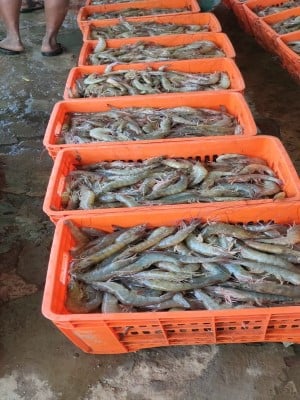
Summary
Aquafeed management should aim at making available the best quality, formulated aquafeed in adequate amounts and at the right time and location. Feeding methods and techniques are as important as feed quality and are closely interdependent. Feeding practices must be continually modified and adapted to account for natural and induced changes in feeding activity and preferences as the animals grow and environmental conditions change.
Knowledge of shrimp behavior and feeding habits and continuous feedback on pond environmental parameters and shrimp population management must be considered together. This must be coupled with an understanding of the biological aspects of the targeted species and the chemical and biological processes that control, water and pond bottom quality. Effective management practices will produce maximum shrimp growth and survival concurrent with the lowest feed conversion.
To know more connect with us at contact.india@skretting.com